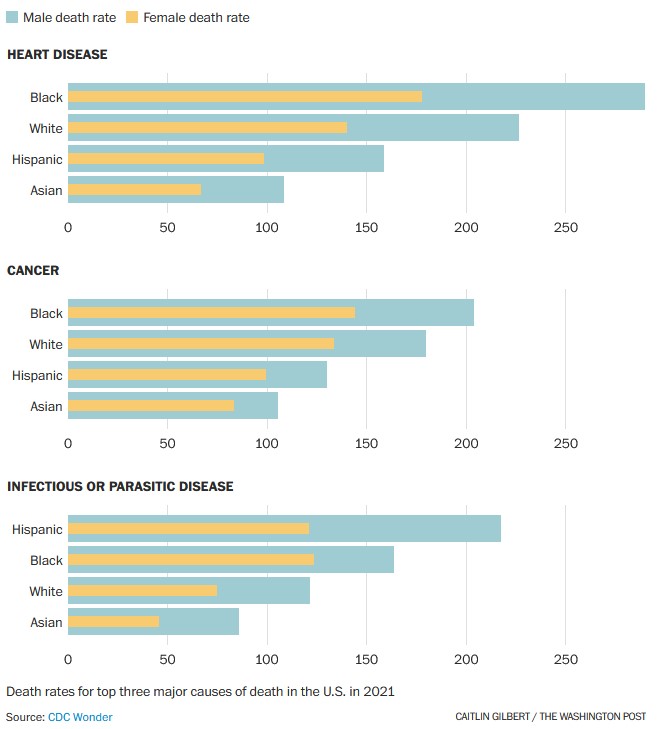
A silent crisis in men's health gets worse
Across the life span -- from infancy to the teen years, midlife and old age -- boys and men are more likely to die than girls and women
The Washington Post, By Tara Parker-Pope and Caitlin Gilbert, April 17, 2023
A silent crisis in men's health is shortening the life spans of fathers, husbands, brothers and sons.
For years, the conventional wisdom has been that a lack of sex-specific health research mainly hurts women and gender minorities. While those concerns are real, a closer look at longevity data tells a more complicated story.
Across the life span — from infancy to the teen years, midlife and old age — the risk of death at every age is higher for boys and men than for girls and women.
The result is a growing longevity gap between men and women. In the United States, life expectancy in 2021 was 79.1 years for women and 73.2 years for men. That 5.9-year difference is the largest gap in a quarter-century. (The data aren't parsed to include differences among nonbinary and trans people.)
"Men are advantaged in every aspect of our society, yet we have worse health outcomes for most of the things that will kill you," said Derek Griffith, director of Georgetown University's Center for Men's Health Equity in the Racial Justice Institute.“We tend not to prioritize men's health, but it needs unique attention, and it has implications for the rest of the family. It means other members of the family, including women and children, also suffer.”
The longevity gap between men and women is a global phenomenon, although sex differences and data on the ages of greatest risk vary around the world and are influenced by cultural norms, record keeping and geopolitical factors such as war, climate change and poverty.
Mortality higher in men than in women at all stages of life
Ratio of male-to-female death rates across ages for the U.S., other countries

The result is a growing longevity gap between men and women. In the United States, life expectancy in 2021 was 79.1 years for women and 73.2 years for men. That 5.9-year difference is the largest gap in a quarter-century. (The data aren’t parsed to include differences among nonbinary and trans people.)
“Men are advantaged in every aspect of our society, yet we have worse health outcomes for most of the things that will kill you,” said Derek Griffith, director of Georgetown University’s Center for Men’s Health Equity in the Racial Justice Institute.“We tend not to prioritize men’s health, but it needs unique attention, and it has implications for the rest of the family. It means other members of the family, including women and children, also suffer.”
The longevity gap between men and women is a global phenomenon, although sex differences and data on the ages of greatest risk vary around the world and are influenced by cultural norms, record keeping and geopolitical factors such as war, climate change and poverty.
But data looking at health risks for boys and men in the United States paint a stark picture.
Men are at a greater risk of dying from covid-19 than women, a gap that cannot be explained by rates of infection or preexisting conditions. The age-adjusted death rate for covid was 140 deaths per 100,000 for males and 87.7 per 100,000 for females. More men die of diabetes than women. The death rates for men are 31.2 per 100,000 people vs. 19.5 per 100,000 for women. The cancer mortality rate is higher among men — 189.5 per 100,000 — compared with 135.7 per 100,000 for women. Black men have the highest cancer death rate at 227.3 per 100,000. Among Black women, the cancer mortality rate is 149 per 100,000. Death rates for boys and teens ages 10 to 19 (44.5 per 100,000) far outpace that for girls (21.3 per 100,000). Even among infants, the mortality rate is higher for boys (5.87 per 1,000 live births) vs. girls (4.95 per 1,000). Men die by suicide nearly four times more often than women, based on 2020 data from the Centers for Disease Control and Prevention. The rate of suicide is highest in middle-aged White men, but teen boys also face a high risk. In 2020, 72 percent of all motor vehicle crash death victims were male. Men also accounted for 71 percent of pedestrian deaths, 87 percent of bicyclist deaths and 92 percent of motorcyclist deaths.
American mortality divides
Age-adjusted death rates per 100,000 people by race, gender and cause of death

Advocates for more research into men’s health say the goal isn’t to steal resources from women, girls and gender minorities.
“Some people think health care is a zero sum gain and one dollar to men’s health is taking something away from women,” said Ronald Henry, president and co-founder of the Men’s Health Network, an advocacy group. “That’s wrong. We are fully supportive of women’s health efforts and improving quality of life for women.” Derek Griffith is the director of Georgetown University’s Center for Men’s Health Equity in the Racial Justice Institute. He is also a health management and policy professor at Lombardi Comprehensive Cancer Center. (Lisa Helfert/Courtesy Derek Griffith)

Derek Griffith is the director of Georgetown University’s Center for Men’s Health Equity in the Racial Justice Institute. He is also a health management and policy professor at Lombardi Comprehensive Cancer Center. (Lisa Helfert / Courtesy Derek Griffith)
But by viewing men as the privileged default, health experts are ignoring important sex differences that could illuminate health issues across gender and minority groups.
For instance, for years the widely held belief in medical circles was that women used too many health-care resources compared to men. As a result, men were viewed as the standard for seeking health care, while women were often dismissed as hysterical or “anxious” when they sought care.
“We used to think women were overutilizing health care, and men were doing it correctly,” Griffith said. “What we realized was that women were doing it better, mostly for preventive care, and men were actually underutilizing health care.” Explaining the longevity gap
The reasons behind the longevity gap aren’t fully understood, but the global nature of the disparity suggests that biology probably plays a strong role.
For instance, high levels of testosterone, which can weaken the immune response, may be a factor in why men, and male mammals in general, are more vulnerable to parasitic infections. Estrogen may explain why women have lower rates of heart disease throughout life — and why the gap narrows after women reach menopause. (Even though estrogen appears to be protective in women, studies in the 1970s showed that when estrogen was given to men, instead of being protective, it caused double the rate of heart attacks as those in a placebo group.)
Cultural biases around masculinity that teach boys and men to hide their feelings and not complain also can influence men’s health.
“Depression in men is quite deceptive,” said Marianne J. Legato, a physician and founder of the Foundation for Gender-Specific Medicine in New York. “Men are socially programmed to not complain. Suicide is often unexpected as an early end to a man’s life compared to that of a woman.”
Cultural expectations to remain stoic can also delay men’s care. For instance, although diseases such as diabetes, heart disease and hypertension are common in men and women, men often wait longer to seek care and the illnesses are diagnosed at later stages, leading to more damage and poorer outcomes.
“It’s an interesting conundrum and in many ways it’s not well understood,” said cardiologist Steven Nissen, chief academic officer for the Cleveland Clinic. “Men need to pay close attention to cardiovascular risk factors. Treating risk factors early can mitigate a lot of the risk.”
Men also are known to engage in more risky behaviors, such as drug and alcohol use, smoking and reckless driving. While the reasons behind these trends aren’t fully understood, behavioral risks are also a reason men’s health doesn’t get studied, Griffith said.
“It’s hard to convince people that men’s health is an issue if we think it’s just because men don’t do what they’re supposed to do,” he said.
Fewer doctor visits
An oft-cited concern is that men are also less likely to visit the doctor. Although boys and girls visit the pediatrician at the same rate, the trend changes in adulthood and medical visits by men decline. CDC data show that the physician visit rate in 2018 among females was almost 40 percent higher — 3.08 visits per woman vs. 2.24 per man.
One reason is that women regularly visit the gynecologist in their reproductive years. “There is no similar pathway for men,” Nissen said.
But even when visits for pregnancy are excluded, research suggests that women still are twice as likely as men to schedule regular annual exams and use preventive services. Doctors say that men are most likely to visit the doctor because of a sports injury or for the “Viagra” visit — when they seek treatment for erectile dysfunction. As a result, sports medicine physicians and urologists are encouraged to use those visits to check blood pressure, cholesterol and other indicators of overall health.
“Stamina and sexual health are two of the top things that men think about,” said Howard LeWine, an internal medicine physician at Brigham and Women’s Hospital in Boston and chief medical editor at Harvard Health Publishing. “When you’re 20, 30 and a man, you really don’t think about health. The idea of going to a doctor to prevent cancer or heart disease — I don’t think it’s in the mind of many men until something has happened to them.”
The irony is that men for years have been overrepresented in medical research, often at the expense of women, according to a seminal 1985 report that prompted more government investment in women’s health research.
“Men who were overrepresented in medical studies before are still underrepresented in terms of clinical care,” said Harvey Simon, an internal medicine physician and founder of Harvard Men’s Health Watch, a newsletter devoted to men’s health. Lack of support
Men’s health advocates say one of the biggest factors is a lack of infrastructure to support research specifically focused on men’s health.
For years, the Men’s Health Network has lobbied for the creation of an Office of Men’s Health, similar to the Office of Women’s Health in Health and Human Services Department. Proposed legislation, however, has consistently failed to win support.
While some health systems claim to have departments focused on men’s health, the care is often focused on urologic and prostate health rather than cardiac care, mental health or other issues that afflict men at high rates.
The topic of men’s health simply hasn’t caught on as something that advocates, corporate sponsors and politicians want to get behind. While the pink-ribbon has been elevated to iconic status to signal breast cancer awareness, nothing in men’s health has achieved the same level of attention.
“There is an empathy gap,” Henry said. “There are people who shrug and say, ‘Yes, men die younger. That’s the way the world is.’ It doesn’t need to be that way. If we devote attention and resources, we can change the outcomes for men.”





